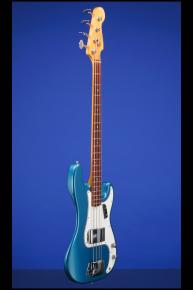Under The Bed For Forty-Five Years
This 13-inch-wide lightweight Lake Placid Blue (nitrocellulose lacquer) "dream" bass guitar weighs just 9.30 lbs. and has a nut width of just under 1 3/4 inches and a full bass scale length of 34 inches. Solid alder body, contoured on back and lower bass bout, one-piece maple neck with a wonderful medium-to-thick profile, and veneer rosewood fretboard with 20 original medium-jumbo frets and pearl dot position markers. Headstock decal with Fender "Transition" logo in silver with black trim, "Precision Bass" in black below it, and four patent numbers and one design number beneath. Single circular string tree. Fender cloverleaf tuners. Four-bolt neck plate with serial number "171443" between the top two screws. One split black eight-polepiece pickup with a great, fat output of 10.85k. Three-layer white/black/white plastic pickguard with thirteen screws. Two controls (one volume, one tone) on the lower treble bout. Chrome knobs with knurled sides and very lightly 'domed' tops. Combined four-saddle (ridged)bridge/tailpiece. Complete with both the original bridge (with original mute) and pickup covers, the original thumbrest on the treble side of the pickguard, and the metal shield under the pickguard. The neck is stamped "5 OCT 66C" and the pots are stamped "304 6631" (Stackpole August 1966). There are a few very small and totally insignificant indentations / surface marks on the back and sides of the body - however, this bass is still in very close to mint (9.50) condition. This is an exceptional (under the bed for forty-five years) and totally original example of a "custom-color" Precision Bass, and one of the best sounding Basses that we have ever heard! Without doubt the finest Lake Placid Blue Precision Bass that we have ever seen or even heard about! Complete with the original Fender instruction manual with matching serial number and original Fender black leather guitar strap. Housed in its original Fender three-latch black rectangular hardshell case with black leather ends and reddish orange plush lining (9.00).
Although this is a CBS guitar, the changes made by them in late 1964 were purely cosmetic: The "Transition" logo replaced the "Spaghetti" logo and "pearloid" fingerboard dots replaced the "clay" dots. These two details were the only changes until 1968 when the tuners were changed, the decal was changed yet again and most importantly, a Polyester "thick" finish replaced the original nitrocellulose lacquer.
The Precision Bass, with its revolutionary new shape, was launched in 1951, and originally had a slab body. It was not until 1954, with the introduction of the Stratocaster, that Fender contoured the body. All early Precision Basses had one-piece maple necks, but in 1959, a slab-board rosewood fretboard was introduced, and then finally in 1962 the "veneer" rosewood fretboard was introduced.
Until the Precision, the bass was an upright acoustic instrument that was difficult to hear and cumbersome to transport. Leo Fender's invention allowed musicians to hold their instrument like a guitar, opening the bass world to curious guitar players, and allowing bass players a level of freedom they had not yet encountered. Due to the bass's solid body construction, it could be amplified to any level, giving it new found aural presence. In its first fifteen years of development, the Precision Bass changed as much as the music it influenced and the musicians it inspired, having been played by everyone from The Shadows to Led Zeppelin.
Translate:











